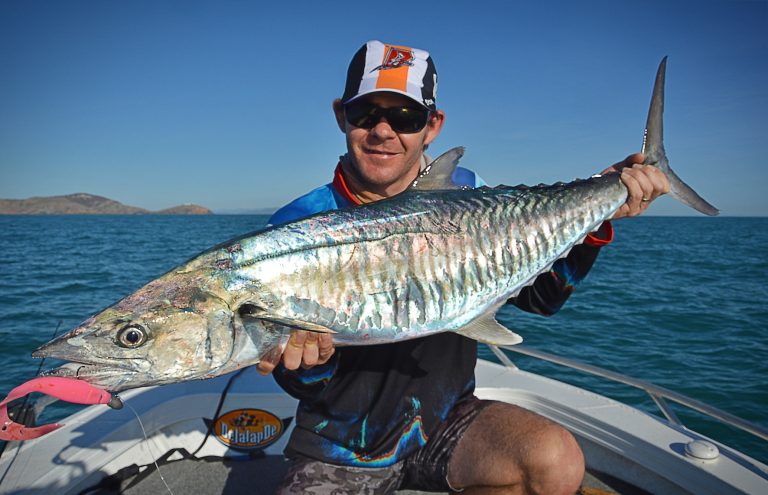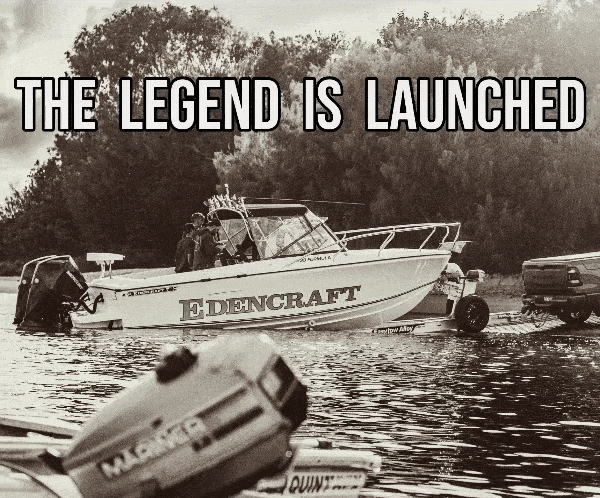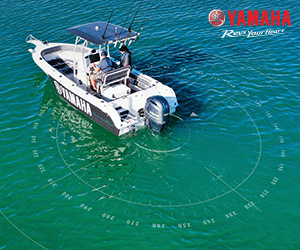4 Day NQ Safari
The plan was set! Four days of hardcore fresh and salt water fishing with my brother to experience as much diversity the fish-rich waters of Townsville and its surrounds had to offer.
Day 1. Part 1
I’ve had some pretty bad luck with weather in the past while I’ve ventured north, so on this recent trip in September, I didn’t even bother looking at seabreeze before stepping on the plane.
To my surprise the winds were light and the sky blue when I arrived in Townsville.
My brother knows how to give me a warm welcome: the boat was hitched and ready to go upon my arrival.
Our plan was to chase fingermark off the cape using large soft plastics.
With the revolution of soft vibes and micro jigs, fishing soft plastics in deep water has become somewhat of a forgotten technique, particularly in south east Queensland.
Over the past couple of years my brother has been catching some very respectable fingermark and coral trout on large curly tail soft plastics fished on the reefs and bommies out from Cape Cleveland.
We left as the sun rose over the horizon, from the amazing new boat ramp in the Ross River.
We were greeted with sloppy conditions as we crossed the bay towards Cape Cleveland.
As soon as we arrived at our chosen spot, we started to sound around, looking for bait and larger predators that may be hanging off the edge.
We found some bait stacked up on the northern side of the bommie so the electric motor was deployed and set on anchor just down current of the bait.
The plan was to cast our large Delalande Sandras on half-ounce jig heads up current and hop them back over the edge of the bommie, hoping for a fingermark or trout.
I didn’t even get a chance to tie my lure on by the time my brother had already hooked up to something so large that was stripping lots of drag.
Pretty quickly we suspected it wasn’t a fingermark, but rather some sort of pelagic.
Unfortunately the fish rubbed through the leader so we can only speculate.
Over the next hour it was a bit slow, with just a few good hits and some small bycatch to keep us busy enough.
We moved around the general area and found a school of bait on the edge of another bommie plus some decent fish not far away.
They showed up on the sounder as long, skinny fish, so we were certain enough they’d be Spanish mackerel.
Knowing this, I immediately grabbed my stickbait outfit and cast out a fast sinking stickbait.
Long casts were made ahead of the boat and the lure was worked past the edge of the structure.
Apart from one hit that left large peg-like teeth marks on my lure, the mackerel didn’t show any other interest in my stickbait.
I switched back to my much lighter fingermark outfit and went back to bouncing it over the drop off.
Just a few casts later I hooked something with considerable weight as I had quickly retrieved my lure from the bottom.
During the twenty minute fight, we tossed around some possibilities of what it could be: we thought a cod when it slugged it out in the deep, and then a cobia when it quickly surfaced, to finally agree on a large tuna while it continually circled the boat.
However to our surprise, up popped a nice Spanish mackerel, luckily hooked in the side of the head.
There were a few nervous moments while we tried to avoid the 30lb leader on its razor sharp teeth until the gaff found its mark and my personal best Spaniard, around 13kg, was in the boat.
A few necessary boastful photos were taken and tomorrow night’s dinner was sorted.
After that it was quiet, so we went looking for more pelagics.
Throwing stickbaits around some of the exposed bommies produced a hit from a Spaniard and queenfish, but unfortunately they didn’t find the hooks.
Our next move was to cast some smaller 4 -5 inch curly tail plastics in close to the headland targeting a trevally and trout.
While cruising around the rocks with the electric, Justin soon hooked into an impressive-looking bar-cheeked coral trout that was just under 50cm.
When the sun got a bit too high, we moved back inside the bay in search of a barra.
We worked shallow running hard bodies and lightly weighted plastics around the rocks while looking for bait or feeding fish.
It didn’t take Justin long to hook a nice 60cm barra while he slowly rolled a 5 inch paddle tail plastic on a 1/6 ounce jig head.
After a spirited battle on light spin gear, the fish was subdued and then quickly released after a few photos.
Not long after this, the northerly got up and so we made a call to bash our way home through the slop.
Day 1. Part 2
After a big day on the salt, we decided to mix it up a bit and fish the fresh of a local river for a big night-time barra.
We launched around 7:30pm and after a quick trip we, had reached our destination.
The plan was to cast and slowly roll 6 – 7 inch paddle tail soft plastics around the edge of the weed beds with a ¼ ounce jighead and 7/0 hook.
After 2 hours of casting with only one hit, things were looking a bit bleak.
I was sitting back enjoying a beer and listening to the football on the radio when Justin’s large paddle tail got wacked.
Unfortunately the 7/0 missed its mark and we thought the opportunity was missed.
However, the next cast out to the exact same spot had Justin’s rod nearly getting ripped from his grasp.
Immediately the beast took to the air and left a splash like nothing I have seen before.
The splash was as if someone had thrown a besser block into the river.
The barra then took off to the other side of the river, peeling a locked drag at will. After battling through the thick weed, we guided the big girl out into the middle of the river and into the waiting net.
The barra measured an impressive 107cm and would have pushed the 20kg mark.
That was enough for a huge day’s fishing.
Day 2.
The plan for Day 2 was to sleep in and fish the afternoon in the sweetwater for a jungle perch.
Fishing these little rainforest streams for such secretive fish has to be my favourite thing about fishing around Townsville.
The first destination was a small creek that we had fished 12 months ago when we caught about a dozen jungle perch.
As we left the cane fields and walked into the creek, we were astounded to see that there was virtually no water in the system.
Areas only 12 months ago we had pulled good-sized jungle perch were now bone dry.
We walked for about 500 metres and found that the large waterhole that was full of JPs last time still had some water in it.
It didn’t take long to get interest from the landlocked fish.
Within half a dozen casts I hooked a good fish right at my feet on my small surface popper.
After a determined battle, my personal best JP of 40cm was lip-gripped and carefully lifted out of the water.
When I gently lifted the fish up for a quick photo I realised how much of a battle it has been for these little guys in the prolonged drought. This particular fish was the skinniest and dullest looking jungle perch I have ever seen.
After a quick photo it was carefully released to battle on until the much-needed wet season.
The decision was made to respect these fish by leaving them alone and instead driving another 30 minutes further north to a system that we knew would have more water.
We arrived mid-afternoon starting from the brackish section hoping for a sweetwater jack to tick off our list.
We had no interest until we got to the skinnier sections of fresh water with deeper pools.
We landed about half a dozen average size JP’s on both surface lures and small weedless soft plastics before making our way home.
Day 3.
For Day 3, we planned a morning of targeting sooty grunter in the fresh of the Herbert River.
Again, I fished surface, while Justin used a soft plastic. He was the first to hook up, with a nice sized sooty falling to a lightly weighted 4-inch curly tail plastic. Other than that and a few half-hearted hits on the surface, the sooties proved elusive for another hour or so.
After we disturbed a large and understandably angry scrub bull, and dodged a large brown snake while sunning itself, we came to a large pool.
It had some promising boulders surrounded by deep water.
It didn’t take long to catch the interest of a pack of sooties when I cast my Sebile Splasher out along the face of the boulders.
The fish – in packs of 4-5 – were ravenous as they crunched my surface lure on every pause.
This was my first experience of catching sooties on surface and my inexperience soon showed as my fine gauge bass and JP trebles were quickly straightened after two fish.
To rectify this, I changed to a small fizzer with stronger hooks. Only a couple of casts later, and to my surprise, I landed a nice sized jungle perch that beat the sooties to the fizzer.
We continued to walk up steam and found a likely looking place at the base of some large rapids.
Three casts later we had a double hook up from a pack of sooties sitting out of the main current.
It is amazing how hard these little nuggets hit a surface lure and fight well above their weight.
Pound for pound they must be one of the hardest fighting fish available.
One cast into the area had five spectacular hits on my fizzer before the hooks finally found their place into an average size fish.
Frustratingly a sooty close to 50cm was shadowing my much smaller fish right up to the bank.
Although there where a lot of sooties in this area, they quickly shut down and it was time to clamber our way back to the car, while avoiding the rather large snakes.
Day 4
A fishing trip around Townsville isn’t complete without a mission to the spectacular Hinchinbrook Channel.
Although there were neap tides, we felt confident that we could tick off one of the fish that had avoided us so far – the hard-hitting mangrove jack.
Action was slow for the first hour until the tide started to run out a little.
We made our way from one of the creeks into the channel.
The tide was just starting to run out of the mangroves when I saw a few egrets hunting some bait in the shallows.
We worked our way along these shallow flats in 3 feet of water while casting small soft plastics towards the shallow mangroves.
While we were hoping for a barramundi, salmon or trevally to be hunting bait around the shallow mangrove edge, to our surprise Justin soon hooked a 43cm jack.
Not long after it was carefully released, Justin soon hooked another smaller one, again right up on the shallow flats.
Since the tide was a bit high for fishing the snags, we remained on shallow flats with small lightly weighted plastics to go onto catch another similar sized mangrove jack and grunter.
After this, the tide had run out just enough to cast lures at some likely looking structure, which resulted in another 39cm jack, a barra and some trevally and queenfish, all caught on small lightly weighted soft plastics.
Although the fishing up the channel wasn’t spectacular, we had constant bites for most of the day, keeping us interested enough.
We also found a few new spots worth exploring come better tides with more run. Plus we learned that jacks can be successfully targeted away from any notable structure.
The next day while on my way back to the big smoke, I felt more than satisfied on how the four-day tour had turned out. The great thing about our trip was that everything we set out to do is easily accessible to anyone with a sense of adventure and sturdy tinny most of the year.





